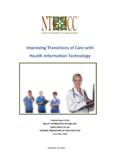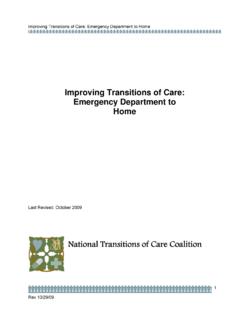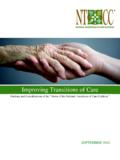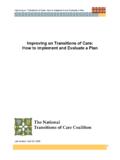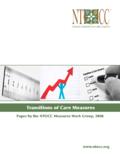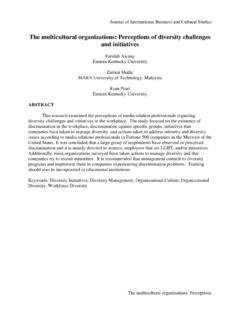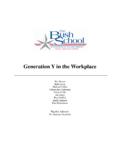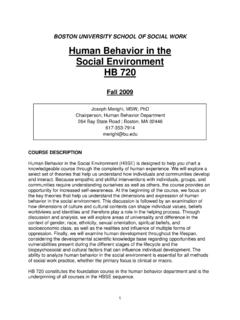Transcription of Cultural Competence: Essential Ingredient for Successful ...
1 A. For the purpose of this document, the term client/patient refers to the person being served by a health care professional. The term can be interchanged with consumer, resident, beneficiary, member, or other term appropriate to the professional s setting. 1 Cultural competence : Essential Ingredient for Successful Transitions of Care Health care professionals increasingly recognize the crucial role that culture plays in the healthcare of a client or patienta and the need to deliver services in a culturally competent manner. Cultural competence is Essential to Successful , client-/patient-centered transitions of care. This tool provides information about culture and Cultural competence , as well as strategies and resources to enhance professionals capacity to deliver culturally competent services during transitions of care.
2 DEFINITIONS What Is Culture? Culture is the integrated pattern of human behavior that includes thoughts, communications, actions, customs, beliefs, values, and institutions of a racial, ethnic, religious, or social group. Culture may include, but is not limited to, race, ethnicity, national origin, and migration background; sex, gender, gender identity, or gender expression; sexual orientation and marital or partner status; age and socioeconomic class; religious and political belief or affiliation; and physical, mental, or cognitive disability. Given the many facets of culture, it is worth noting that every exchange is, potentially, a cross- Cultural exchange; two individuals are unlikely to be identical in every aspect of Cultural identity and expression.
3 What Is Multiculturalism? Multiculturalism is an orientation that recognizes, supports, and accommodates a variety of sociocultural practices and traditions .. and promotes the value of diversity as a core principle. 2 What Is Cultural competence ? Cultural competence is the process by which individuals and systems respond respectfully and effectively to people of all cultures, languages, classes, races, ethnic backgrounds, religions, and other diversity factors in a manner that recognizes, affirms, and values the worth of individuals, families, and communities and protects and preserves the dignity of each. 3 What Is Linguistic competence ? a. For the purpose of this document, the term client/patient refers to the person being served by a health care professional.
4 The term can be interchanged with consumer, resident, beneficiary, member, or other term appropriate to the professional s setting. 2 Linguistic competence is a key component of Cultural competence . On an operational level, it entails providing readily available, culturally appropriate oral and written language services to limited English proficiency (LEP) members [individuals] through such means as bilingual/bicultural staff, trained medical interpreters, and qualified translators, 4 among other practices. What Are Culturally and Linguistically Appropriate Services? Culturally and linguistically appropriate services (CLAS) are respectful of and responsive to Cultural and linguistic needs. 5 In other words, culturally and linguistically competent practitioners, systems, and policies yield culturally and linguistically appropriate services.
5 What Are Care Transitions? Care transitions, or transitions of care, refers to the movement patients make between health care practitioners and settings as their condition and care needs change during the course of a chronic or acute illness. 6 What Is Transitional Care? Transitional care is a set of actions designed to ensure the coordination and continuity of health care as patients transfer between different locations or different levels of care within the same location. 7 Cultural competence is an Essential Ingredient of transitional care. STRATEGIES TO ENHANCE Cultural competence AND IMPROVE TRANSITIONS OF CAREb Striving for Cultural competence requires ongoing action on multiple levels. In developing its standards and indicators for Cultural competence in social work practice, the National Association of Social Workers (NASW) identified multiple aspects of Cultural These components, outlined below with action tips, can guide all health care providers in delivering culturally competent services during transitions of care.
6 Ethics and Values Cultural competence complements the values of self-determination, client-/patient-centeredness, and individual dignity and worth inherent in many health care professions. Strategies Adhere to professional values, ethics, and standards, while recognizing how these values both conflict with and accommodate the needs of a multicultural clientele. Refer to the Universal Declaration of Human Rights9 and other United Nations conventions and declarations10 for global context related to Cultural competence . Self-Awareness Self-awareness of personal and Cultural values, beliefs, and biases informs practice and influences relationships with clients/patients. Strategies Develop an understanding of one s personal and Cultural values and beliefs and how those values and beliefs influence practice.
7 3 Understand and acknowledge how fear, ignorance, and systemic oppression (including, but not limited to, ageism, classism, ethnocentrism, heterosexism, racism, and sexism) influence one s attitudes and actions, and take steps to eliminate personal bias. Use Cultural self-awareness to appreciate the multicultural identities of clients/patients and colleagues. Cross- Cultural Knowledge Knowledge regarding various Cultural groups contributes to culturally competent practice, provided health care professionals acknowledge individual differences within Cultural groups and avoid stereotypes. Strategies Develop and maintain understanding of the history, traditions, values, family systems, and communication patterns of major client/patient groups served.
8 Develop and maintain knowledge regarding the influence of culture on help-seeking behaviors and perceptions of health, illness, health care treatments, disability, caregiving roles, and death and dying among client/patient groups served. Cross- Cultural Skills Health care providers apply Cultural self-awareness and cross- Cultural knowledge in the development and employment of cross- Cultural skills. Strategies Use appropriate methodological approaches, skills, and techniques that reflect an understanding of the role of culture in the helping process. Demonstrate genuineness, empathy, warmth, openness, and flexibility to facilitate client/patient engagement throughout service delivery. Distinguish between culturally normative and symptomatic behaviors and assess Cultural strengths and challenges and their impact on functioning and health.
9 Communicate information about Cultural groups or characteristics in a strengths-based manner. Culturally and Linguistically Appropriate Service Delivery Cultural and linguistic competence is reflected not only in interactions between individual health care professionals and clients/patients but also in service delivery systems. Strategies Incorporate Cultural competence in the mission and goals of the organization. Effectively use culturally and linguistically appropriate organizational and community resources on behalf of clients/patients. Maintain knowledge regarding the Cultural composition of targeted client/patient populations, including preferred languages, and tailor services to maximize client/patient access and transitional care outcomes.
10 Engage clients/patients from various Cultural groups in development and evaluation of service delivery systems and transitional care. 4 Conduct individual and organizational assessment, on an ongoing basis, of Cultural and linguistic competence in health care delivery. Workforce A multicultural workforce engaged in ongoing education and training in Cultural and linguistic competence is integral to providing culturally and linguistically appropriate services. Strategies Implement organizational policies and practices, including hiring and retention policies, that foster multiculturalism within all levels of the organization, ensuring various client/patient groups served are represented among personnel. Promote acquisition and application of specialized expertise (such as bilingual and bicultural skills) among staff to ensure services are culturally appropriate.
